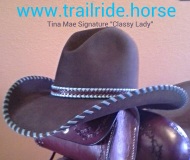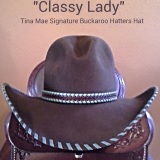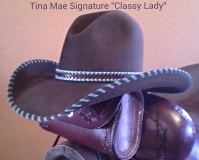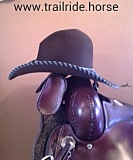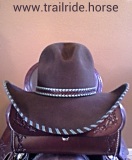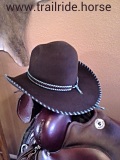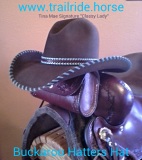"Classy Lady" 10X Tina Mae Signature Buckaroo Hatters Hat
SKU:
$405.00
$405.00
Unavailable
per item
This Hat is a Brown 10X all beaver, has the same brim and crown style as the black hat, but this hat has a laced brim and a matching laced leather hat band but in kangaroo turquoise leather you Can order this One Here just by adding to your cart. MUST Give Hat Size in "NOTE"... To Change Anything , color, Hat Band Ect.. you Can Order this Hat by adding it to your Cart.. don't Forget the Hat SIZE in the Notes. You Can Choose Any Color they Have... If Wanting different Color or hat band You Must add to NOTES along with Phone Number when ordering.
**DISCOUNT COUPON CODE: DISCOUNT20
(**SAVE 20.00 ON SHIPPING!** DON'T FORGET TO ADD CODE!)
Buckaroo Hatters purchase’s three types of hat bodies most if not all custom hatters use the same hat bodies. Buckaroo Hatters makes a 100X ( 100% beaver), 50X ( 50% beaver and 50% wild hare) and a 10X ( 100% wild hare) Ultimately the quality of a hat is determined by the user. A hat which fits you well, meets your individual requirements, and is appealing to you, is all you need.Beaver fur is the standard for measuring a hat’s quality, the higher the percentage of beaver in a hat the better the hat quality. Beaver fur, felts tighter, which results in a dense, light weight, thin hat which holds its shape in the rain longer than a lesser quality hat. The more densely felted the hat is the better it resist rain penetrating into the felt. Even a 100% beaver fur hat will eventually loose its shape if left out in a pouring rain long enough.
Wild hare fur can also be felted fairly tight and is more commonly available than beaver fur. Using wild hare fur for a hat body makes the hat more affordable and is soft to the touch. Wild hare fur does not felt as tightly (dense) as beaver fur. To construct an affordable hat body with good weather resistance properties felters experimented with combining beaver and rabbit fur to produce various blends of beaver-wild hare fur hat body. The blend combines the softness of wild hare but the stiffness of beaver. Eventually, hats were given an “X” rating to insinuate the quality of the hat. The difficulty in using the “X” quality to determine a hat’s quality is, there is no industry standard for an “X” value. The “X” can be what ever the manufacturer or the custom hatter choose to assign to the hat’s “X” value. The “X” rating was invented by the hat factory to assist customers in determining hat qualities and to increase sales. Companies would rate their poor hats without an “X” and up to as many “Xs” the merchant felt appropriate for the better quality hats or would best assist sales. It is believed in the beginning each “X” represented 10% beaver fur. A 10-X hat once represented 100% beaver fur was used to construct the hat body. However today some hat shops and hatters have changed the scale again by listing their hats as 200-X, 500-X, 1,000-X and up to 2500-X. The “X” rating only has value when it is known what the value of “X” represents for the amount of beaver fur used. Each hatter is free to label their hats with what ever “X” value they choose.
**DISCOUNT COUPON CODE: DISCOUNT20
(**SAVE 20.00 ON SHIPPING!** DON'T FORGET TO ADD CODE!)
Buckaroo Hatters purchase’s three types of hat bodies most if not all custom hatters use the same hat bodies. Buckaroo Hatters makes a 100X ( 100% beaver), 50X ( 50% beaver and 50% wild hare) and a 10X ( 100% wild hare) Ultimately the quality of a hat is determined by the user. A hat which fits you well, meets your individual requirements, and is appealing to you, is all you need.Beaver fur is the standard for measuring a hat’s quality, the higher the percentage of beaver in a hat the better the hat quality. Beaver fur, felts tighter, which results in a dense, light weight, thin hat which holds its shape in the rain longer than a lesser quality hat. The more densely felted the hat is the better it resist rain penetrating into the felt. Even a 100% beaver fur hat will eventually loose its shape if left out in a pouring rain long enough.
Wild hare fur can also be felted fairly tight and is more commonly available than beaver fur. Using wild hare fur for a hat body makes the hat more affordable and is soft to the touch. Wild hare fur does not felt as tightly (dense) as beaver fur. To construct an affordable hat body with good weather resistance properties felters experimented with combining beaver and rabbit fur to produce various blends of beaver-wild hare fur hat body. The blend combines the softness of wild hare but the stiffness of beaver. Eventually, hats were given an “X” rating to insinuate the quality of the hat. The difficulty in using the “X” quality to determine a hat’s quality is, there is no industry standard for an “X” value. The “X” can be what ever the manufacturer or the custom hatter choose to assign to the hat’s “X” value. The “X” rating was invented by the hat factory to assist customers in determining hat qualities and to increase sales. Companies would rate their poor hats without an “X” and up to as many “Xs” the merchant felt appropriate for the better quality hats or would best assist sales. It is believed in the beginning each “X” represented 10% beaver fur. A 10-X hat once represented 100% beaver fur was used to construct the hat body. However today some hat shops and hatters have changed the scale again by listing their hats as 200-X, 500-X, 1,000-X and up to 2500-X. The “X” rating only has value when it is known what the value of “X” represents for the amount of beaver fur used. Each hatter is free to label their hats with what ever “X” value they choose.


